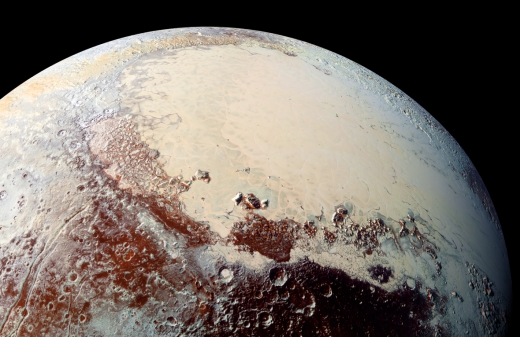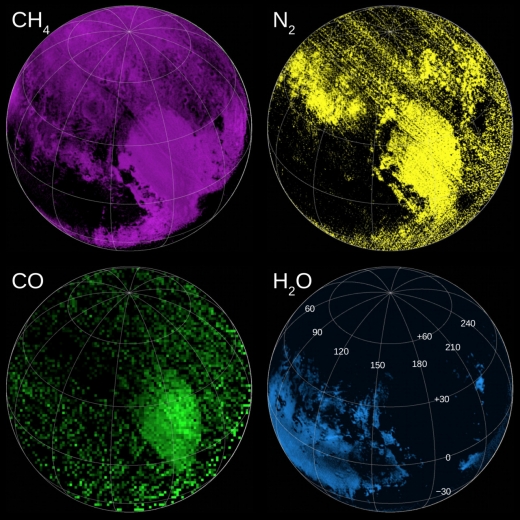The ongoing work of mining New Horizons’ abundant data from the outer system continues at a brisk pace. But missions occur in context, and we also have discoveries made at comet 67P/Churyumov-Gerasimenko by the European Space Agency’s Rosetta probe to bring to bear. The question that occupies Christopher Glein and Hunter Waite (both at SwRI) is how to explain the chemistry New Horizons found at Pluto and what it can tell us about Pluto’s formation.
At the heart of their new paper in Icarus is the question of Pluto’s molecular nitrogen (N2), which plays a role on that world similar to methane on Titan, water on Earth and CO2 on Mars. All are volatiles, meaning they can move between gaseous and condensed forms at the temperature of the planet in question. We’ve learned that solid N2 is the most abundant surface ice visible to spectroscopy on Pluto, as witness the spectacular example of Sputnik Planitia.

Image: NASA’s New Horizons spacecraft captured this image of Sputnik Planitia — a glacial expanse rich in nitrogen, carbon monoxide and methane ices — that forms the left lobe of a heart-shaped feature on Pluto’s surface. SwRI scientists studied the dwarf planet’s nitrogen and carbon monoxide composition to develop a new theory for its formation. Credit: NASA/Johns Hopkins University Applied Physics Laboratory/Southwest Research Institute.
Anyone glued to their screen during New Horizons’ 2015 flyby will recall the surprise generated by Sputnik Planitia’s youthful terrain, now believed to be the result of the flow of solid N2. Scientists also found that nitrogen can sublimate at Pluto’s surface, so we have a volatile cycle that causes surface pitting and frosts, one that likewise accounts for the existence of Pluto’s atmosphere. Given the importance of nitrogen, the issue of its origin looms large because of what it can tell us about Pluto’s formation, and by extension that of other outer system objects.
Here the crossover with the Rosetta data is helpful. What Glein and Waite are suggesting is that Pluto may owe its existence to comets, accumulating the N2 observed by New Horizons through accretion. Says Glein, with a nod to the nitrogen-rich ice of Sputnik Planitia:
“We’ve developed what we call ‘the giant comet’ cosmochemical model of Pluto formation. We found an intriguing consistency between the estimated amount of nitrogen inside the glacier and the amount that would be expected if Pluto was formed by the agglomeration of roughly a billion comets or other Kuiper Belt objects similar in chemical composition to 67P, the comet explored by Rosetta.”

Image: New Horizons not only showed humanity what Pluto looks like, but also provided information on the composition of Pluto’s atmosphere and surface. These maps — assembled using data from the Ralph instrument — indicate regions rich in methane (CH4), nitrogen (N2), carbon monoxide (CO) and water (H2O) ices. Sputnik Planitia shows an especially strong signature of nitrogen near the equator. SwRI scientists combined these data with Rosetta’s comet 67P data to develop a proposed “giant comet” model for Pluto formation. Credit: NASA/Johns Hopkins University Applied Physics Laboratory/Southwest Research Institute.
Whether Pluto formed from the accretion of cometary ices or from materials with a chemical composition closer to that of the solar nebula remains an open question, with the paper addressing both possibilities and finding both to be consistent with the data. Tangled up with the question is the issue of carbon monoxide (CO) and the low CO/N2 ratios observed at Pluto. The problem is that these ratios should be much higher than what we find in Pluto’s atmosphere. How to explain the missing carbon monoxide?
There are implications here for what may still lie beneath the icy world’s surface. From the paper:
…we have performed aqueous geochemical calculations showing the great thermodynamic instability of CO dissolved in cold (liquid) water, even for a restricted metastable equilibrium system… The destruction of CO to formate or carbonate species… would be strongly favored if Pluto has or had a subsurface ocean. This mechanism can be applied to the cometary model, but not to the solar model as the CO/H2O ratio is too large in the latter. Hence, the cometary model seems preferable, with more options to reconcile the CO/N2 ratio.
And implications for Pluto’s continuing surface activity are also present:
We note that the burial and aqueous destruction hypotheses for missing CO are not necessarily mutually exclusive. A major implication of these processes is that the observed composition of Pluto cannot be completely primitive, even if its N2 is indeed primordial. This resonates with the dynamic geology seen by New Horizons (Moore et al., 2016).
Numerous questions remain to be answered, but the authors propose an evolutionary scenario that begins with Pluto accumulating cometary nitrogen and CO, with subsequent interactions accounting for loss of the CO and outgassing of N2. This takes into account the surface accumulation of the latter at Sputnik Planitia and cometary ‘resupply’ of a small amount of CO that mixes with surface nitrogen. This is one of various possible scenarios, but it is consistent with the data the paper examines and points to future work.
Among many questions remaining, the issue of how much N2 might be inside Pluto looms large, as does its distribution in the crust, rocky core and possible liquid water ocean. We’d also like to know whether the abundance of N2 found at comet 67P is representative of the cometary population at large and of larger icy Kuiper Belt Objects.
And among ten questions posed by the authors in their conclusion, this one is significant: Why do we lack any detection of CO2 on Pluto while finding it on Triton, and is there a consistent way of resolving the question with regard to the lack of CO on both bodies? This gets us into the broad issue of the mechanisms that provide volatiles to worlds like these. Check the paper’s conclusion for a useful wrap-up of future directions to be taken with the New Horizons data, and the areas where new data will be required.
The paper is Glein and Waite, “Primordial N2 provides a cosmochemical explanation for the existence of Sputnik Planitia, Pluto,” Icarus Vol. 313 (October, 2018), pp. 79-92 (abstract / preprint).



Very interesting paper. I really like how they explain their reasoning, rather than hide it.
What I find fascinating is that Pluto may have a partially liquid subsurface ocean. That may mean that there are pockets of liquid water in the slush.
This adds to the inventory of subsurface liquid water worlds. While I don’t think this in any way implies life on these worlds, it does suggest clement temperatures, even though under high pressure, which may act as refuge arks for Earth deep-sea life in some remote future. I would like to see some work on biological processes under such conditions, starting with samples of ocean vent microorganisms to see whether these conditions can be adapted to. While space colonies might provide refuges for Earth surface-life, these various bodies with oceans might offer huge environments for life adapted to the cold, dark, deep oceans.
Triton has a higher temperature due to more tidal heating than Pluto. Consequently, there is more Co2 in the atmosphere on Triton than Pluto. Nitrogen has a much lower freezing temperature and boiling point than Co2 so the Co2 stays frozen on the surface but the molecular nitrogen can be a gas.
Pluto’s Sputnik Planitia seems to be a mix of N2 and CO, though just how much of the latter is unknown. The mostly N2 ice would be an incredible resource for would-be terraformers. One estimate for its total volume from the paper is 8.7 million cubic kilometres, though more likely half that. Roughly as much N2 as in Earth’s atmosphere.
Except that Pluto is 70% Rock….
Comets are not just made of ice. Plus a few planetoids may have made their “contributions” to Pluto’s makeup as well over the ages. Note the very recent discovery of a rocky body out there in the Kuiper Belt:
https://centauri-dreams.org/2018/05/09/asteroid-at-the-edge/
Can we not make/accept Pluto and its kin as a third type of actual planet distinct from the terrestrial and Jovian worlds in the Sol system? Certainly Pluto, Sedna, et al are not carbon copies of either Earth or Jupiter.
We now know of thousands of exoworlds in the Milky Way galaxy, the merest tip of the cosmic iceberg. Many of them are bizarre places unlike anything found in our celestial neighborhood. Yet we accept them as planets.
As we are bound to find far more worlds with even more unexpected qualities, doesn’t it seem rather antiquated to stick to the two main types of planets we have known until the 1990s – rocky and gassy – when we have all these examples which do not neatly fit into a predesignated box. This includes Pluto.
I wonder if the absence of CO and CO2 might be due, at least in part, to some sort of catalytic reaction (with some of the other chemical constituents comprising the catalyst) that only occurs at very low temperatures and/or near-vacuum pressures? (The closest “pseudo-analog”–because they don’t involve catalytic reactions–that I can think of is eutectic alloys, which melt at a lower temperature than their constituent metals do individually.)
The idea of “Pluto the comet” have been proven! ;)
We live in an age when we can talk about the dunes of Pluto and not be referring to some science fiction story:
https://www.plymouth.ac.uk/news/scientists-reveal-the-secrets-behind-plutos-dunes
Made of methane ice grains, no less.
From Pluto, Earth to transit sun on July 12
By Bruce McClure and Deborah Byrd in Astronomy Essentials |
Human World | July 9, 2018
Earth transits seen from Pluto are rare. The last one happened in 1931, a year after Clyde Tombaugh discovered Pluto. It won’t happen again for 161 years.
http://earthsky.org/astronomy-essentials/earth-transit-from-pluto-july-12-2018
Mattias Malmer • September 14, 2018
Feast your eyes on comet 67P’s surface, with depth cues added
In November 2014, a little lander named Philae disconnected from the European Space Agency’s Rosetta spacecraft and descended to comet 67P/Churyumov-Gerasimenko. Philae was supposed to fire a set of harpoons and attach itself to the surface, but things didn’t go as planned. The spacecraft bounced, tumbled and eventually ended up in the shadow of a cliff. From there, it sent us wonderfully strange hints about where it was in the form of pictures.
The images showed a fractured jumble of jagged rocks so alien that it wasn’t even obvious which way was up or down. People started assembling the images into panoramas to create something a little less confusing, and it helped — a little. On comet 67P, the atmospheric cues that our eyes have evolved to judge distances on Earth are not present, so everything has the same sharp contrast. This, and the fact that the surface is so sharp, makes the images almost fractal in nature.
I wanted to help my eyes perceive the landscape in a more familiar way, so I added some human-readable depth cues. I carefully segmented the landscape, following every edge that I could find, and based on the overlaps I created a very crude depth estimation. To simulate atmospheric scattering, I added increasing amounts of bluish tint and a loss of contrast as the landscape moves farther away from the camera.
Here’s the result:
http://www.planetary.org/blogs/guest-blogs/2018/comet67p-depth-cues.html